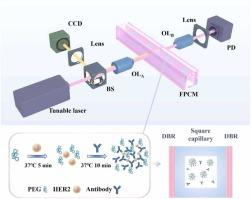用于超灵敏生物传感的无修饰光流体法布里-帕氏毛细微腔
IF 3.7
1区 化学
Q1 CHEMISTRY, ANALYTICAL
引用次数: 0
摘要
超灵敏光学传感器已成为疾病早期干预和个性化治疗、环境污染源检测、物理参数测量、细胞代谢物及衍生物分析等各个领域不可或缺的设备。在这项研究中,我们开发了一种采用方形毛细管石英管进行超灵敏度检测的光流法布里-帕姆毛细微腔(FPCM)传感器。得益于方形毛细管侧壁的高度平行和侧向光场约束,沉积的分布式Bragg反射器对光行走和衍射具有良好的耐受能力,其质量(Q)因子为1.0×10 26。此外,光场与分析物分子之间的高度重叠表明其具有较高的折射率(RI)灵敏度,可达201.1 nm/RIU。因此,使用FPCM传感器可以实现2.2×105 - RIU-1的超高质量系数(FOM)和7.11×10 - RIU的超低检测限。实验结果表明,FPCM传感器具有高重复性、优异的长期稳定性和极低的系统噪声,可用于高精度的多次原位测试。在生物传感应用中,我们通过利用聚乙二醇(PEG)对山羊抗人免疫球蛋白G (Anti-IgG)的非特异性结合作用,初步评估了聚乙二醇(PEG)对蛋白质聚集的影响。随着蛋白质浓度的变化,可以同时捕捉到强度和波长的变化,表明FPCM可以实现多参数传感。最后,我们检测到一种典型的人表皮生长因子受体2 (HER2)乳腺癌监测蛋白,结果表明,通过peg增强方法,HER2蛋白特异性结合的检测限低至100 ag/mL,检测范围跨越7个数量级。值得注意的是,FPCM生物传感器具有成本效益,响应时间快,无需标记或修改即可进行超灵敏度检测的能力,使其成为早期癌症筛查和疾病监测,环境污染源检测和物理参数测量的重要工具。本文章由计算机程序翻译,如有差异,请以英文原文为准。

Modification-free optofluidic Fabry-Pérot capillary microcavities for ultra-sensitivity biosensing
Ultrasensitive optical sensors have become an indispensable device in various fields, such as disease early intervention and personalized treatment, environmental pollution source detection, physical parameters measurement, and analysis of cellular metabolites and derivatives. In this study, we have developed an optofluidic Fabry-Pérot capillary microcavity (FPCM) sensor employing a square-capillary quartz tube for the ultra-sensitivity detection. Benefit from the highly parallel of square capillary side wall and lateral light field confinement, the deposited distributed Bragg reflector have good tolerance to the light walk of loos and diffraction, showing a fascinating quality (Q) factor of 1.0 × 10⁶. Moreover, the high overlap between the optical field and analyte molecules always indicates a high refractive index (RI) sensitivity of 201.1 nm/RIU. As a result, an ultra-high figure of merit (FOM) of 2.2 × 105 RIU−1 and an ultra-low detection limit of 7.11 × 10⁻⁸ RIU can be achieved with the FPCM sensors. The experimental results also demonstrated the FPCM sensor with high repeatability, exceptional long-term stability and remarkably low system noise for multiple in-situ tests with high accuracy. In biosensing applications, we initially assessed the effect of polyethylene glycol (PEG) on protein aggregation by leveraging its non-specific binding effect on goat anti-human immunoglobulin G (Anti-IgG). Both the intensity and wavelength changes can be simultaneously captured with the protein concentration changes, indicating multiparameter sensing is possible on the FPCM. Finally, a typical breast cancer monitoring protein of Human Epidermal Growth Factor Receptor 2 (HER2) was detected, showing a detection limit for HER2 protein-specific binding as low as 100 ag/mL and an extensive detection range spanning seven orders of magnitude with the PEG-enhanced approach. Notably, the FPCM biosensor exhibits cost-effectiveness, rapid response time, and the capability for ultra-sensitivity detection without labeling or modification, making it as a crucial tool for early cancer screening and disease monitoring, environmental pollution sources detection, and physical parameters measurement.
求助全文
通过发布文献求助,成功后即可免费获取论文全文。
去求助
来源期刊

Sensors and Actuators B: Chemical
工程技术-电化学
CiteScore
14.60
自引率
11.90%
发文量
1776
审稿时长
3.2 months
期刊介绍:
Sensors & Actuators, B: Chemical is an international journal focused on the research and development of chemical transducers. It covers chemical sensors and biosensors, chemical actuators, and analytical microsystems. The journal is interdisciplinary, aiming to publish original works showcasing substantial advancements beyond the current state of the art in these fields, with practical applicability to solving meaningful analytical problems. Review articles are accepted by invitation from an Editor of the journal.
 求助内容:
求助内容: 应助结果提醒方式:
应助结果提醒方式:


